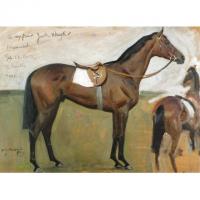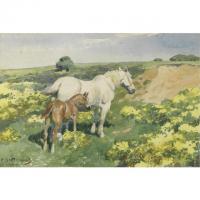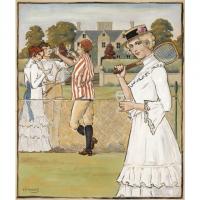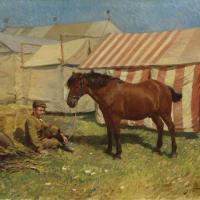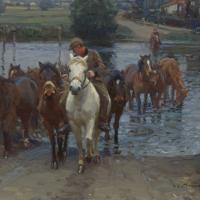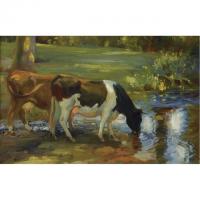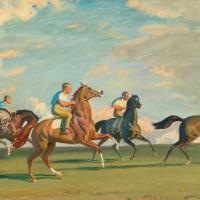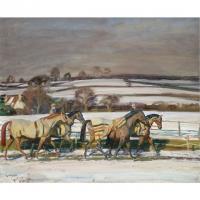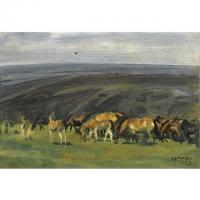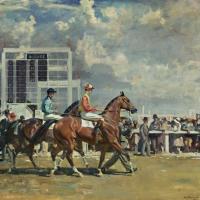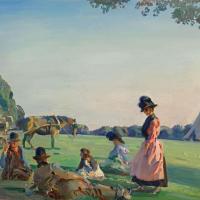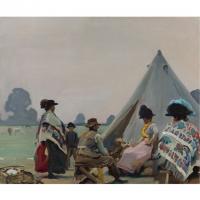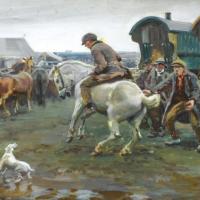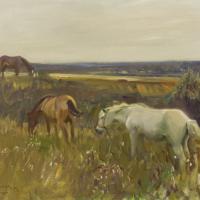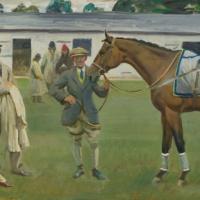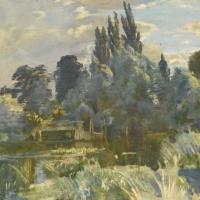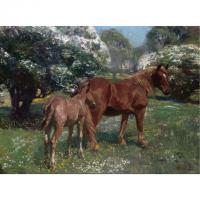Sir Alfred James Munnings
A Humble Horse
$450.00
A Huntsman
$450.00
A Mare With Her Foal
$450.00
An Afternoon's Tennis
$450.00
Ascot
$450.00
Behind The Tents
$450.00
Crossing The Ford
$450.00
Dairy Cows By A Stream
$450.00
Early Morning Newmarket
$450.00
Exercising
$450.00
Exmoor Landscapes1
$450.00
Exmoor Landscapes2
$450.00
Exmoor Ponies
$450.00
Going Out At Epsom
$510.00
Gypsies On The Downs
$450.00
Hop Pickers
$450.00
Horse Fair
$450.00
Horses at Pasture
$450.00
Kempton Park Stables
$450.00
Langham Mill Pool
$450.00
Mendham
$450.00
Sir Alfred James Munnings
Sir Alfred James Munnings (1878-1959)
Sir Alfred James Munnings (8 October 1878 – 17 July 1959) was known as one of England's finest painters of horses, and as an outspoken critic of Modernism. Engaged by Lord Beaverbrook's Canadian War Memorials Fund, he earned several prestigious commissions after the Great War that made him wealthy.
Alfred Munnings was born on 8 October 1878 at Mendham Mill, Mendham, Suffolk, across the River Waveney from Harleston in Norfolk to Christian parents. His father was the miller and Alfred grew up surrounded by the activity of a busy working mill with horses and horse-drawn carts arriving daily. After leaving Framlingham College at the age of fourteen he was apprenticed to a Norwich printer, designing and drawing advertising posters for the next six years, attending the Norwich School of Art in his spare time. When his apprenticeship ended, he became a full-time painter. The loss of sight in his right eye in an accident in 1898 did not deflect his determination to paint, and in 1899 two of his pictures were shown at the Royal Academy Summer Exhibition. He painted rural scenes, frequently of subjects such as Gypsies and horses. He was associated with the Newlyn School of painters, and while there met Florence Carter-Wood (1888–1914), a young horsewoman and painter. They married on 19 January 1912 but she tried to kill herself on their honeymoon and did so in 1914. Munnings bought Castle House, Dedham, in 1919, describing it as 'the house of my dreams'. He used the house and adjoining studio extensively throughout the rest of his career, and it was opened as the Munnings Art Museum in the early 1960s, after Munnings's death. Munnings remarried in 1920; his second wife was another horsewoman, Violet McBride. There were no children from either marriage. Although his second wife encouraged him to accept commissions from society figures, Munnings became best known for his equine painting: he often depicted horses participating in hunting and racing.
Munnings was elected president of the Royal Academy of Arts in 1944. He was made a Knight Bachelor in July of the same year, and waz appointed a Knight Commander of the Royal Victorian Order in the 1947 New Year Honours. His presidency is best known for the valedictory speech he gave in 1949, in which he attacked modernism. The broadcast was heard by millions of listeners to BBC radio. An evidently inebriated Munnings claimed that the work of Cézanne, Matisse, and Picasso had corrupted art. He recalled that Winston Churchill had once said to him, "Alfred, if you met Picasso coming down the street would you join with me in kicking his ... something something?" to which Munnings said he replied, "Yes Sir, I would".
Munnings died at Castle House, Dedham, Essex, on 17 July 1959. His ashes were interred at St Paul's Cathedral, with an epitaph by John Masefield ('O friend, how very lovely are the things, The English things, you helped us to perceive'). After his death, his wife turned their house in Dedham into a museum of his work. The village pub in Mendham is named after him, as is a street there.
Munnings was portrayed by Dominic Cooper in the film Summer in February, which was released in Britain in 2013. The film is adapted from a novel by Jonathan Smith.
His immensely popular sporting art works have enjoyed popularity in the United States as well as the United Kingdom and elsewhere. Represented by agents Frost & Reed of London while he was alive, Munnings's works were bought by some of the wealthiest collectors of the day. As of 2007, the highest price paid for a Munnings painting was $7,848,000 for The Red Prince Mare, far above his previous auction record of $4,292,500 set at Christie's in December 1999. It was one of four works by Munnings in the auction. The Red Prince Mare is a 40 by 60 inches (100 by 150 cm) oil on canvas that was executed in 1921 and had an estimate of $4,000,000 to $6,000,000.


